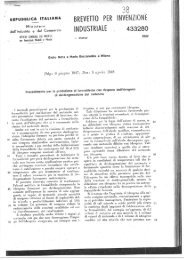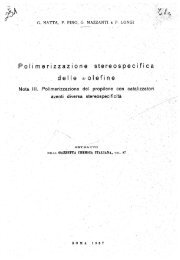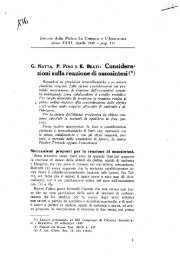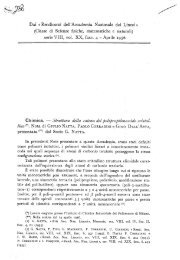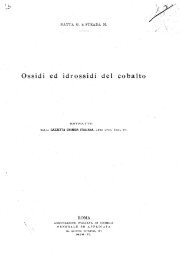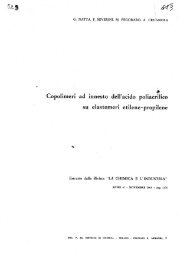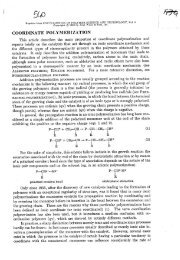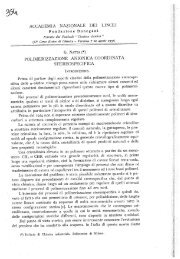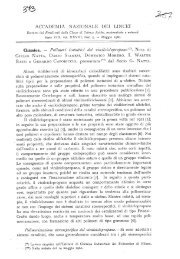n. 7, Ottobre 2003 - Giulio Natta
n. 7, Ottobre 2003 - Giulio Natta
n. 7, Ottobre 2003 - Giulio Natta
You also want an ePaper? Increase the reach of your titles
YUMPU automatically turns print PDFs into web optimized ePapers that Google loves.
2.<br />
Il modello del<br />
“catalizzatore ideale”<br />
The model of<br />
the “ideal catalyst”<br />
3.<br />
La nuova dimensione<br />
nella catalisi eterogenea<br />
The new dimension<br />
in heterogenic catalysis<br />
4.<br />
L’approccio alla “tecnologia<br />
granulo reattore”<br />
The approach towards<br />
“reactor granule” technology<br />
5.<br />
I targets originali e l’impatto<br />
del “catalizzatore ideale”<br />
The original targets and the<br />
impact of the “ideal catalyst”<br />
manage it on an industrial level.<br />
The catalyst seemed to do whatever it wanted, whenever<br />
it wanted, in terms of catalytic rendering,<br />
selectivity and above all, in the morphology of the<br />
product generated, rendering the system’s management<br />
impossible due to the excess of operative conditions,<br />
which were often in reciprocal conflict. The<br />
product, which was not easily obtained, was of a<br />
poor and unacceptable quality. The market’s reaction<br />
was truly disastrous.<br />
To make up for this dead-end situation it was therefore<br />
necessary to thoroughly understand the<br />
catalyst and to learn to manage it correctly in order<br />
to obtain the properties which, in addition to allowing<br />
for the factory’s flexible, reliable and continual<br />
functioning, would also allow for the production<br />
of the highest quality products and of market<br />
interest.<br />
The technological reaction<br />
In order to overcome such a frustrating state of crisis,<br />
with the second half of the 1960s and the beginning<br />
of the 1970s, various industries initiated projects<br />
aimed at understanding and improving the<br />
catalytic system, the process and the products.<br />
con la Montecatini / Montedison e presso i centri<br />
della Montedison stessa, in particolare a Ferrara.<br />
Lo sforzo mirava a un traguardo ambizioso: capire<br />
il catalizzatore in termini di struttura al punto di<br />
deciderne le proprietà e la possibilità di pilotarne<br />
attività catalitica, stereospecificità, morfologia del<br />
prodotto, proprietà finali e vasta gamma di prodotti<br />
per il commercio.<br />
Il target di un tale programma ambizioso si chiamò:<br />
“Identificazione del catalizzatore IDEALE”. Un<br />
catalizzatore che avesse al contempo tutte le predette<br />
proprietà e le fornisse in maniera appropriata e<br />
gestibile sull’impianto industriale. [Fig. 2 ]<br />
Una volta definito il target, il programma di rimonta<br />
tecnologica fu dinamicamente messo in atto e<br />
realizzato.<br />
La scoperta del supporto “_” MgCl2 avvenuta a<br />
Ferrara nel 1968 aprì la strada a una drammatica<br />
crescita dell’attività catalitica in termini di polimero<br />
generato, oggi tuttora in atto, giungendo a incrementi<br />
di diversi ordini di grandezza rispetto a quella<br />
di catalizzatori di prima generazione.<br />
La scoperta di tutta una famiglia di specifici elettrondonatori<br />
consentì di migliorare la stereospecificità<br />
del catalizzatore portando l’indice di isotatticità<br />
The most systematic and profound efforts were carried<br />
out in Italy, in the university laboratories,<br />
which collaborated with Montecatini / Montedison,<br />
as well as in Montedison’s own centres, particularly<br />
in Ferrara.<br />
The efforts aimed for an ambitious goal: to understand<br />
the catalyst in terms of structure in order to<br />
decide upon the properties and the possibilities of<br />
piloting catalytic activity, stereospecificity, product<br />
morphology, final properties and a wide range of<br />
commercial products.<br />
The target of such an ambitious program was called<br />
“Identification of the IDEAL catalyst”. A catalyst<br />
having all of the aforementioned properties, capable<br />
of providing them in an appropriate and manageable<br />
way within the industrial system. [Fig. 2 ]<br />
Once the target was defined, the program of technological<br />
revamping was dynamically carried out<br />
and realised.<br />
The discovery of the “_” MgCl2 support made in<br />
Ferrara in 1968 paved the way to a dramatic growth<br />
in catalytic activity in terms of polymer generated,<br />
still present today, in increments of various sizes<br />
with respect to the first generation catalysts.<br />
The discovery of an entire family of specific elecdel<br />
PP a valori superiori al 99,9%.<br />
Ma il fattore che ha esercitato l’impatto più rilevante<br />
sulla gestione degli impianti, la vita industriale e<br />
il successo commerciale del PP è stato la comprensione<br />
del meccanismo di crescita del granulo-polimero<br />
catalizzatore. La comprensione e il dominio<br />
dei principi che regolano la crescita del polimero<br />
sul catalizzatore e la conseguente capacità di controllare<br />
e pilotare il fenomeno di genesi del polimero<br />
nel “granulo reattore” hanno costituito la base di<br />
una vera rivoluzione tecnologica.<br />
Si è trattato dell’apertura di una nuova frontiera<br />
nella catalisi eterogenea, della scoperta di una<br />
nuova dimensione nella catalisi in generale.<br />
[Fig. 3 ]<br />
L’impatto principale di una tale acquisizione scientifica<br />
è stata la possibilità di concepire e realizzare<br />
industrialmente la tecnologia del “granulo reattore”.<br />
[Fig. 4 ]<br />
L’impatto industriale delle nuove tecnologie<br />
Tale nuova, rivoluzionaria acquisizione tecnologica,<br />
parte fondamentale nel difficile e ambizioso processo<br />
di creazione del “catalizzatore ideale”, è stata la<br />
principale base e il punto di partenza per il rilancio<br />
50<br />
51



